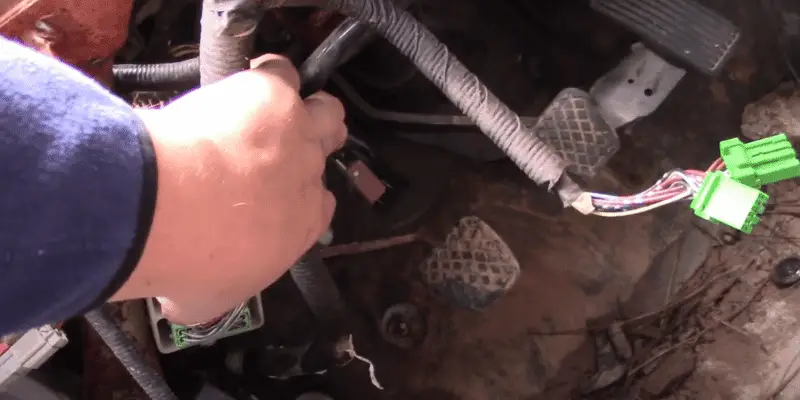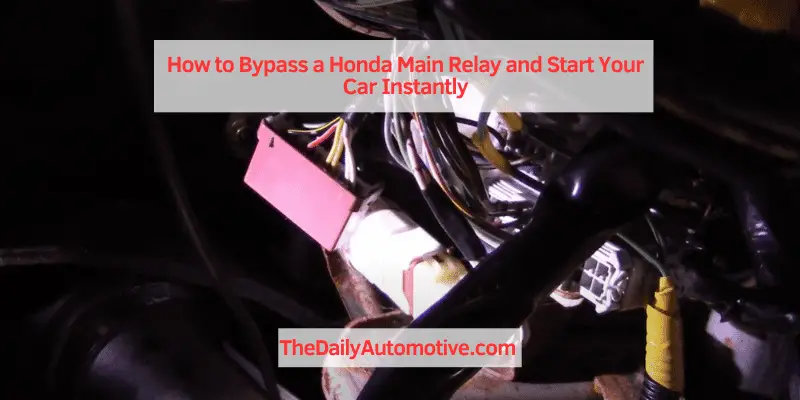How to Bypass a Honda Main Relay and Start Your Car Instantly
To bypass a Honda main relay, locate the relay box, remove the cover, and carefully pull out the main relay. When your Honda vehicle is not starting due to a faulty main relay, you can bypass it by following a simple procedure.
The main relay is generally located in the relay box, under the hood. To bypass it, you will need to locate the relay box, remove the cover, and carefully pull out the main relay. By doing this, you can temporarily bypass the faulty main relay and allow your vehicle to start.
However, it is important to note that this is a temporary solution, and you should consult a professional mechanic to rectify the main relay issue for a permanent fix.
Understanding The Honda Main Relay
The Honda Main Relay plays a crucial role in the starting and running of the car. By understanding its function, you can learn how to bypass it and troubleshoot any related issues efficiently. Discover the steps to bypassing a Honda Main Relay for smoother driving experience.
The Honda main relay is a crucial component in your vehicle’s electrical system. It serves the function of controlling power flow to the fuel pump, ignition system, and other important components. In this section, we will dive deeper into what the Honda main relay is and its function, why you might need to bypass it, and common symptoms of a faulty main relay.
What Is The Honda Main Relay And Its Function?
The Honda main relay, also known as the PGM-FI Main Relay, is responsible for supplying power to the fuel injection system in Honda vehicles. Its main function is to control the electrical circuit that powers the fuel pump and other essential components, ensuring proper fuel delivery and ignition.
Here are the key points about the Honda main relay and its function:
- The main relay is typically located under the dashboard on the driver’s side or in the engine compartment fuse box.
- It is an electromagnetic switch that is activated when you turn the ignition key to the ON position.
- When the main relay is activated, it allows power to flow from the battery to the fuel injection system, ignition system, and other vital components.
- The relay works in conjunction with the engine control unit (ECU) to ensure that the proper amount of fuel is delivered to the engine for combustion.
- Its primary purpose is to provide a reliable power supply to the fuel pump, enabling your vehicle to start and run smoothly.
Why Would You Need To Bypass The Main Relay?
In certain situations, you may find yourself needing to bypass the Honda main relay. While it is not a common occurrence, there are some instances where bypassing the main relay can be useful. Here are a few reasons why you might need to do so:
- Testing purposes: When diagnosing an issue with the fuel or ignition system, bypassing the main relay can help determine if the relay is faulty or if there is another problem.
- Temporary solution: In the event of a failed main relay, bypassing it can act as a temporary fix, allowing you to start your vehicle and get it to a service center for repair.
- Retrofitting or modifications: If you are performing modifications or retrofitting aftermarket parts in your Honda, bypassing the main relay may be necessary to ensure compatibility and proper operation.
Common Symptoms Of A Faulty Main Relay
A faulty main relay can cause various issues in your Honda vehicle. It is essential to recognize the common symptoms to address the problem promptly. Here are some signs that your main relay may be faulty:
- Intermittent starting problems: Your vehicle may experience difficulty starting or may not start at all. This can happen randomly or after sitting for a while.
- Engine stalling: If the main relay fails while the vehicle is running, the engine could suddenly stall, leading to an unexpected loss of power.
- No fuel pressure: A faulty main relay can result in the fuel pump not receiving power, causing a lack of fuel pressure in the system.
- No power to the ignition system: Without proper power supply from the main relay, the ignition system may not receive the necessary electrical current, resulting in engine misfires or a complete loss of spark.
If you notice any of these symptoms, especially if they occur consistently, it is advisable to have your Honda inspected by a qualified technician to determine if the main relay is the underlying cause.
Understanding the Honda main relay, its function, reasons for bypassing it, and the common symptoms of a faulty main relay can help you diagnose issues and take appropriate action. By knowing how this crucial component operates, you can ensure the proper functioning of your Honda vehicle’s fuel injection and ignition systems.

Precautions Before Bypassing The Honda Main Relay
Before bypassing the Honda main relay, it is important to take certain precautions to ensure a successful procedure. These precautions include disconnecting the battery, wearing safety gloves, and following step-by-step instructions to avoid any damage or accidents.
Before attempting to bypass the Honda Main Relay, there are some important safety measures you need to take. It is crucial to follow these precautions to avoid any mishaps or damage to your vehicle. Here are the steps you should follow:
- Disconnect the battery: Before starting any work on your vehicle’s electrical system, it’s essential to disconnect the battery. This will prevent any potential danger of electric shock or damage to the vehicle’s electronic components. Make sure to remove the negative terminal first and then the positive terminal.
- Locate the main relay: The main relay in a Honda vehicle is usually located underneath the dashboard, on the driver’s side. It can be identified as a small rectangular or square box with multiple electrical connections. Refer to your vehicle’s manual or consult an expert if you’re having trouble finding it.
- Gather the necessary tools: To successfully bypass the Honda Main Relay, you will need the following tools:
- Screwdriver: You’ll need a screwdriver to remove any panels or covers that may be concealing the main relay.
- Wire cutters/strippers: These tools will be required to cut and strip wires, allowing you to make the necessary connections for the bypass.
- Electrical tape: Electrical tape helps secure the connections and prevents any short circuits.
- Multimeter (optional): Although not essential, a multimeter can be handy in testing the electrical connections during the bypass process.
Follow the guidelines and instructions mentioned in your Honda vehicle manual to ensure a safe and secure bypass. Remember to unplug the electrical connections gently, avoiding any accidental damage. Once you have completed the bypass, reconnect the battery and test the vehicle to ensure proper functioning.
By following these precautions and using the right tools, you can safely bypass the Honda Main Relay and potentially resolve any starting or fuel-related issues in your vehicle. Always exercise caution and, if unsure, it’s best to consult a professional mechanic or a Honda dealership for assistance.
Step-By-Step Guide To Bypassing The Honda Main Relay
This step-by-step guide provides a comprehensive approach to bypassing the Honda main relay. With clear instructions and easy-to-follow methods, you can quickly overcome relay issues and ensure your Honda operates smoothly.
Are you experiencing issues with your Honda’s main relay and want to bypass it? Don’t worry, we’ve got you covered with this step-by-step guide on how to bypass the Honda main relay. By following these instructions, you’ll be able to get your vehicle up and running in no time.
Let’s dive in!
Removing The Main Relay Cover:
- Locate the main relay: The main relay is usually located in the engine compartment, on the driver’s side.
- Open the hood: Pop the hood of your Honda and secure it in place.
- Locate the main relay cover: The main relay is protected by a plastic cover. Find the cover and carefully remove it using a screwdriver or a similar tool.
- Disconnect the battery: Before proceeding, make sure to disconnect the negative terminal of your car’s battery to ensure your safety.
Identifying The Main Relay Pins:
- Get familiar with the main relay: The main relay will have multiple pins sticking out of it.
- Refer to the wiring diagram: Use the wiring diagram for your specific Honda model to identify the main relay pins that need to be bypassed. This diagram can usually be found in your vehicle’s service manual or online.
Understanding The Wiring Diagram:
- Analyze the wiring diagram: Take your time to understand the layout and connections indicated in the wiring diagram.
- Identify the relevant pins: Look for the pins that are associated with the main power and fuel pump circuits.
- Note the pin numbers: Make a note of the pin numbers you need to bypass or connect.
Bypassing The Main Relay With A Jumper Wire:
- Gather the necessary tools: You’ll need a jumper wire and a wire stripper or a similar tool.
- Prepare the jumper wire: Cut a suitable length of wire and strip both ends.
- Connect the jumper wire: Insert one end of the jumper wire into the pin that connects to the main power circuit. Then, connect the other end of the wire to the pin associated with the fuel pump circuit.
- Secure the connections: Ensure the connections are firmly secured and won’t come loose during operation.
- Reconnect the battery: Once the connections are secure, reconnect the negative terminal of the car’s battery.
By following these simple steps, you’ll be able to bypass the Honda main relay and get your car back on the road. Remember, if you’re not confident in your abilities, it’s always best to consult a professional mechanic for assistance.
Safe driving!
Safety Checks And Testing After Bypassing
After bypassing the Honda main relay, it is important to conduct safety checks and testing to ensure everything is in working order and avoid any potential issues in the future. Proper testing and verification are essential for the smooth and reliable operation of the vehicle.
When it comes to bypassing a Honda main relay, it is crucial to perform safety checks and thorough testing afterward to ensure that everything is in proper working order. By following these steps, you can verify the bypass connection, reconnect the battery, test the ignition, check for any warning lights or error codes, and conduct a test drive to guarantee that your Honda is functioning correctly.
Verifying The Bypass Connection:
- Inspect the bypass connection to ensure it is securely and properly installed.
- Double-check all the connections and wires to see if there are any loose or damaged parts.
- Look for any signs of overheating or melting, which may indicate a faulty connection.
- Use a multimeter to test the voltage across the bypass connection points. If there is no voltage or a significant drop, recheck the connection.
Reconnecting The Battery And Testing Ignition:
- If you had disconnected the battery during the bypass process, now is the time to reconnect it securely.
- Turn the ignition key to the “on” position and listen for any unusual sounds or vibrations.
- Check if the dashboard lights, such as the check engine light, turn on and off as they should.
- Try starting the engine to ensure it engages smoothly without any issues or hesitations.
Checking For Any Warning Lights Or Error Codes:
- Connect an OBD-II scanner to your Honda’s diagnostic port to check for any stored error codes.
- Look out for any warning lights on the dashboard that remain illuminated, indicating a potential issue.
- Address any error codes or warning lights promptly to avoid further complications.
Conducting A Test Drive To Ensure Proper Functioning:
- Take your Honda for a test drive in a safe and open area, making sure to pay attention to any abnormal noises, vibrations, or performance issues.
- Test the brakes, accelerator, and steering to ensure they are operating smoothly and responsively.
- Monitor the engine temperature gauge to ensure it remains within the normal range.
- Pay attention to any unusual smells, such as burning or fuel odor, which may indicate a problem.
By thoroughly verifying the bypass connection, reconnecting the battery and testing ignition, checking for any warning lights or error codes, and conducting a test drive, you can ensure that your Honda operates safely and efficiently after bypassing the main relay.
Remember, if you encounter any issues during this process, it is recommended to consult a professional mechanic for further assistance.
Common Issues And Troubleshooting Tips
Having trouble bypassing a Honda main relay? Find common issues and valuable troubleshooting tips to help you navigate this obstacle with ease. Discover step-by-step instructions and expert advice to get your Honda back on the road in no time.
If you’re experiencing issues with your Honda not starting, it can be frustrating and leave you wondering what the problem might be. In this section, we will explore some common issues and provide troubleshooting tips to help you diagnose and resolve them.
Troubleshooting If The Car Still Doesn’T Start:
- Check the battery: Make sure the battery has enough charge. A low or dead battery can prevent the car from starting. If needed, jump-start the car or replace the battery.
- Inspect the ignition switch: The ignition switch is responsible for starting the car. If it’s worn out or damaged, it may not engage the starter motor. Inspect the switch for any signs of wear or damage.
- Test the starter motor: The starter motor is responsible for cranking the engine. If it’s faulty, the engine won’t start. Use a multimeter to test the starter motor’s voltage and resistance. If it fails the test, replace it.
- Check the fuel system: Ensure you have enough fuel in the tank. If the fuel pump or fuel injectors are malfunctioning, the engine may not receive the necessary fuel to start. Have a professional inspect and repair any issues with the fuel system.
- Verify the spark plugs: Faulty spark plugs can prevent ignition and result in a no-start condition. Remove the spark plugs and check for signs of wear or damage. Replace them if necessary.
Checking For Loose Connections Or Damaged Wires:
- Inspect the main relay connections: Loose or corroded connections can disrupt the electrical flow and prevent the main relay from functioning correctly. Carefully inspect the connections and clean or tighten them as needed.
- Examine the wiring harness: Look for any frayed or damaged wires in the main relay circuit. Damaged wires can cause intermittent connections or complete failure. If you find any issues, repair or replace the affected wiring.
- Test the main relay: Use a multimeter to check the main relay’s continuity and voltage. If the readings are outside the specified range, the relay may be faulty and should be replaced.
Potential Issues That May Arise After Bypassing The Main Relay:
- Engine stalling or misfiring: Bypassing the main relay can disrupt the normal functioning of the fuel system, potentially leading to engine stalling or misfiring. If you experience these issues, consult a professional to ensure the bypass was done correctly.
- Electrical system damage: Bypassing the main relay can put additional strain on the electrical system, leading to potential damage to other components. Regularly monitor the electrical system for any signs of malfunction or unusual behavior.
- Warranty and legal implications: Modifying or bypassing the main relay may void your vehicle’s warranty or violate legal regulations. Before making any modifications, consult the manufacturer or a professional to understand the potential implications.
Remember, troubleshooting electrical issues can sometimes be complex. If you’re unsure of the problem or how to fix it, it’s always best to seek assistance from a qualified mechanic or technician.
Frequently Asked Questions For How To Bypass A Honda Main Relay
Can You Bypass The Main Relay?
Yes, it is possible to bypass the main relay in your vehicle.
What Happens If Your Main Relay Stop Working?
If your main relay stops working, the electrical circuit that it controls will be disrupted.
How Do You Test A Honda Main Relay With A Multimeter?
To test a Honda main relay with a multimeter, follow these steps:
1. Disconnect the negative battery terminal.
2. Locate the main relay, usually near the driver’s side dashboard.
3. Set the multimeter to measure resistance or ohms.
4. Connect the multimeter leads to the relay terminals.
5. Check for continuity between the terminals.
6. If the multimeter shows infinite resistance, the relay is faulty and needs replacement.
How Do I Know If My Main Relay Is Bad?
To check if your main relay is bad, look for common symptoms like engine starting problems or the car not turning over at all.
Conclusion
Bypassing a Honda main relay can be a useful skill for any Honda owner. By following the steps outlined in this blog post, you can successfully bypass the main relay and potentially solve any starting or fuel delivery issues you may be experiencing.
Remember to exercise caution and consult a professional if you are unsure about any steps in the process. Additionally, regular maintenance and care for your Honda can help prevent the need for main relay bypassing altogether. Keep in mind that this guide is meant for informational purposes only and should not replace professional advice or assistance.
With the right knowledge and understanding, you can confidently troubleshoot and resolve main relay issues in your Honda, keeping it running smoothly for years to come.








